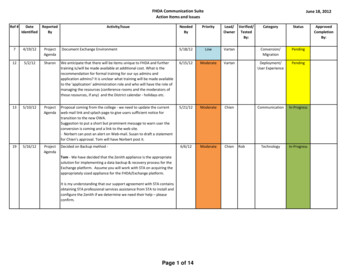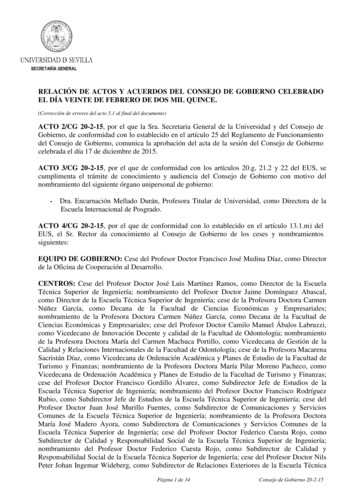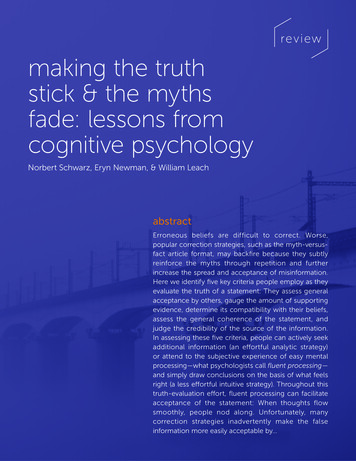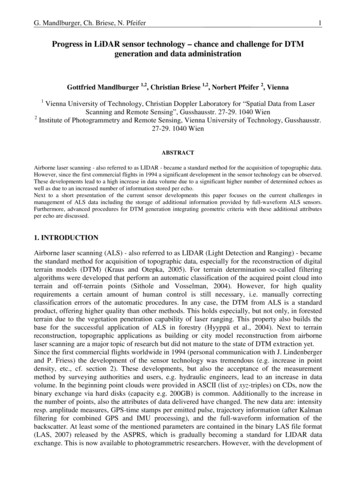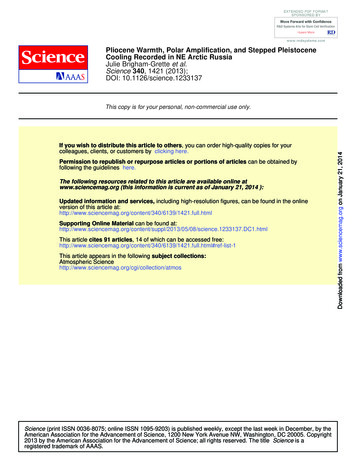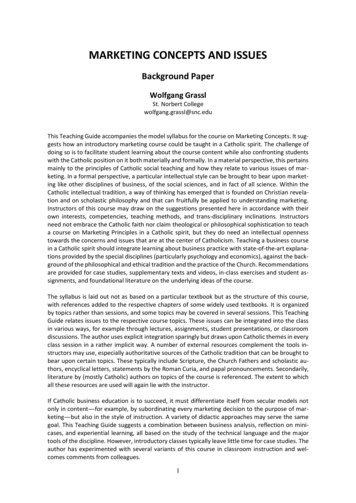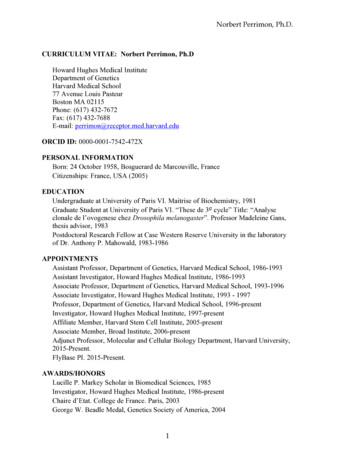
Transcription
Norbert Perrimon, Ph.D.CURRICULUM VITAE: Norbert Perrimon, Ph.DHoward Hughes Medical InstituteDepartment of GeneticsHarvard Medical School77 Avenue Louis PasteurBoston MA 02115Phone: (617) 432-7672Fax: (617) 432-7688E-mail: perrimon@receptor.med.harvard.eduORCID ID: 0000-0001-7542-472XPERSONAL INFORMATIONBorn: 24 October 1958, Bosguerard de Marcouville, FranceCitizenships: France, USA (2005)EDUCATIONUndergraduate at University of Paris VI. Maitrise of Biochemistry, 1981Graduate Student at University of Paris VI. “These de 3e cycle” Title: “Analyseclonale de l’ovogenese chez Drosophila melanogaster”. Professor Madeleine Gans,thesis advisor, 1983Postdoctoral Research Fellow at Case Western Reserve University in the laboratoryof Dr. Anthony P. Mahowald, 1983-1986APPOINTMENTSAssistant Professor, Department of Genetics, Harvard Medical School, 1986-1993Assistant Investigator, Howard Hughes Medical Institute, 1986-1993Associate Professor, Department of Genetics, Harvard Medical School, 1993-1996Associate Investigator, Howard Hughes Medical Institute, 1993 - 1997Professor, Department of Genetics, Harvard Medical School, 1996-presentInvestigator, Howard Hughes Medical Institute, 1997-presentAffiliate Member, Harvard Stem Cell Institute, 2005-presentAssociate Member, Broad Institute, 2006-presentAdjunct Professor, Molecular and Cellular Biology Department, Harvard University,2015-Present.FlyBase PI. 2015-Present.AWARDS/HONORSLucille P. Markey Scholar in Biomedical Sciences, 1985Investigator, Howard Hughes Medical Institute, 1986-presentChaire d’Etat. College de France. Paris, 2003George W. Beadle Medal, Genetics Society of America, 20041
Norbert Perrimon, Ph.D.RNAi Innovator Award, Gene Expression Systems, 2009Elected, American Academy of Arts and Sciences, 2008Elected, American Association for the Advancement of Science, 2009Elected, Associate Member of EMBO, 2011James Stillman Professor of Developmental Biology, 2011-presentElected, National Academy of Sciences, 2013Transformative Research Award, NIH, 2018DISTINGUISHED LECTURES/ KEYNOTESKeynote: FASEB meeting. Protein Phosphatases, 1994. Keynote: DevelopmentalBiology meeting, 1994. Keynote: French Developmental Biology meeting, Marseille,2001. Keynote: Ohio University, 2001.Keynote: Japanese Cell Biology meeting,Yokohama, 2002. Boehringer Ingelheim Lecture, IRCM Montreal, 2002. Keynote: Boneand Teeth GRC, 2003. Sloan Kettering, President Lecture, 2003. R. Williams Lecture(Penn), 2004. Richard Akeson Lecture (Cincinnati), 2004. UCSD, DistinguishedLecturer, 2004. Keynote: FASEB meeting on Growth Factor signaling, 2005. Keynote:Keystone meeting on Signaling Networks, 2006. Sterling Lecture, DFCI, 2006. FoxChase, Distinguished Lecturer, 2008. NCI, Distinguished Lecturer, 2008. Keynote: LorneCancer conference, 2008. Keynote: Protein Phosphorylation, Salk, 2008. Keynote:Sheffield Symposium, 2008. Keynote: RNAi Summit Boston, 2009. Society of Fellows,Scripps 2009. Keynote: ICDB retreat, Star Institute Singapore, 2009. Keynote: Recomb2010, Lisbon. Alma Howard Lecture, McGill, 2011. Keynote: Asian Drosophilameeting, Taiwan, 2011. Keynote: Montreal Bioinformatics User Group, 2011. Blafferlecture MD Anderson, 2011. Keynote: 25th French Drosophila Conference, 2011. SarahWinans Newman lecture, Ann Harbor, 2012. Keynote: Integrative Network Biology2012, Denmark. Keynote: From stem cells to morphogenesis, Curie Institute, 2012.Keynote: UK Genes & Cancer meeting 2012. Keynote: ICSB, Coppenhagen, 2013.Keynote, FEBS JAK/STAT signaling, Nottingham, 2013. Keynote: 2014 NorthwestDevelopmental Meeting. Keynote: 2014 RNAi/CRISPR meting, San Diego. Keynote:2014 Model Organism Resources. Keynote: 2015 NTU opening symposium, Singapore.2015: Annual Kaulenas Lecture. Keynote: 2015 Trans-NIH Developmental BiologyGroup, NIH. Keynote 45th Annual meeting Brazilian Society of Biochemistry andMolecular Biology, Natal, Brazil. 2017 USIAS Public Lecture, Strasbourg. Keynote:Societe Francaise de Genetique, Montpellier 2017. Keynote: ERATO /CREST/PRESTJoint International Symposium “Inter-Organ Communication”, Kyoto 2017. Keynote:“Insect Hormones”, Crete, 2019.PANELS, COMMITTEES, SCIENTIFIC ADVISORY BOARDSPast: NSF.Review Panel. Biological Instrumentation and Resources, 1991-1992.NSF,Academic Research Infrastructure, 1992. NCI, NIH. Member Special Study Section,1994 -1995.NINDS, NIH. AdHoc reviewer, 1997.NSF, Developmental MechanismsReview Panel, 1993-1998. CNRS, Marseille, Scientific Review Committee, 1999.Drosophila Developmental Biology Meeting Committee. Drosophila Crete meetingcommittee, 1995-2008. CNRS review committee, Curie UMR-144, 2002. EMBL,Scientific Review Committee, 2003. MDCN-5, NIH. Study Section, 2003. HFSPFellowship review committee, 2004-2007. ZRG1 FO5 NIH Fellowships Study Section,2
Norbert Perrimon, Ph.D.2004-2006.Carnegie Institute, Scientific Review Committee, 2004. MGB, NIH. StudySection, 2005. Cell Biology Keystone Symposia Study Group, 2005. Scientific ReviewGroup ZNS1 SRB, 2006. ZRG1 FO5 NIH Fellowships Study Section, 2004-2006. NSFSBIR Panel. 2007. GATC, NIH. Study Section, 2008. ERC reviewer, 2009. NIBS,Beijing - Scientific Advisory Board. 2007-2009. Harvard Medical School Scientificadvisory committee on siRNA technology, 2003-2010. Labex-France 2011. DamonRunyon Scientific Advisory Committee, 2007-2011.TSC- Department ofDefense, 2012. NINDS review panel, 2013. NIH study section Development, 2013.Charles A. King Trust Postdoctoral Research Fellowship Program. 2012-2015. TuberousSclerosis writing group 2015. Norwegian Centres of Excellence selection committee,2017. DFG Centres of Excellence selection committee, 2017. HFSP writing group on lifescience and biomedical databases, 2016. Crick Institute, review committee, 2018. CRUK,review panel. 2018, 2019. CIFAR, review panel, 2018. NIH panel, resource. EMBLScientific Review Committee, 2019.Current: U.S. Drosophila Stock Center Advisory Board, 1996-present. IGBMC,Strasbourg - Scientific Advisory Board, 2006-present. Max Planck Institute for Biologyof Aging (Cologne) - Scientific Advisory Board, 2011-present. ERC Horizon 2020,2015-2020. Venitian Institute of Molecular Medicine - Scientific Advisory Board, 2016present. Alliance for Genomics Research (AGR) Scientific Advisory Board, 2016present. Scientific Advisory Board of the TATA Institute of Genetics and Society, 2018present.SEMINARS, RESEARCH PRESENTATIONS, MEETINGS (last 5 years)2013: Yale University. University of Virginia. HMS, retreat. RNAi workshop, HMS.HHMI meeting, Bethesda. TALEN workshop, Janelia Farm. Neuronal DevelopmentSymposium, Baylor. Keystone meeting Snowbird, Cardiac remodeling. Cell Polarity,London. ICR, London. Univ. Colorado, Denver. Broad, Cell Circuitry. AACR, Seattle.Gordon Research Conference Myogenesis, Italy. EXROP, Boston. Cell polarity FASEB,Steamboat. ICSB, Coppenhagen. JAK/STAT, Nottingham. STARR, CSHL. SkirballSymposium, NYU. Stanford. University of Chicago. University of Utah, SLC.2014: Keystone meeting on aging, Steamboat. Rigel pharmaceuticals. NYU AbuDhabi. Northwest Developmental Meeting, Friday Harbor Labs. Stem cell Symposium,University of Washington. Ohio State University. HHMI meeting. NAS, WashingtonDC.Smithies Symposium, Madison. CCSB symposium, Boston. ncRNA meting, San Diego.Wellcome Drosophila course, England. WoodsHole course, aging. NIH, modelorganisms. Renato Paro Symposium, Basel. NCI workshop, Houston. Wiley, New Jersey.Boston Genome. Broad Institute, Boston. Jackson Lab. HTS symposium, Curie Institute.DFCI Cancer retreat. Burnham, San Diego.2015: Keystone meeting on cell signaling, Steamboat. Dow Pharmaceuticals.Nanocourse RNAi, HMS. Boston University. HMS, Department of Genetics Retreat.Workshop, Drosophila meeting, Chicago. NIH, TSC workshop. UNC North Carolina.Keystone meeting, Whistler. Novartis. SDB, Warwick England. IMBA, Vienna. IGBMC,Strasbourg. HHMI. STARR, CSHL. TSC symposium, DFCI. Aging meeting, Crete.“Cancer in flies”, Barcelona. Univ of Milan. ORIP strategic planning, NIH. EXROP,Boston. Flies, Monarch and Mosquitoes, University of Maryland. EDRC, 2015Heidelberg. BIDMC, Boston. NTU, Singapore. ERC, Brussels. Max Planck, Cologne.3
Norbert Perrimon, Ph.D.CSHA, China. FlyBase SAB. Princeton Univ. Univ. Mass Amherst. IRCM, Montreal.NIH, Washington DC. Broad retreat. MCB, Harvard.2016: Keystone meeting Hippo signaling. Lisbon. ERC, Brussels. Janelia Farm. HMS,Departmental Retreat. Nanocourse, Organ communication. NIH, single cell analysis.Muscle meeting, Israel. University of Tenessee, Knoxville. Biocuration 2016, Geneva.HHMI meeting. Starr retreat, CSHL. NHGRI uMOD. Imagine Institut, Paris. VIMM,Italy. World Preclinical Congress, Boston. 45th Annual meeting Brazilian Society ofBiochemistry and Molecular Biology, Natal, Brazil. Wellcome Drosophila Course,Hinxton. ATCG, Orlando. NIH ORIP. CWRU, Cleveland. UTSW, Dallas. HFSP,Database meeting. UNM, New Mexico.2017: AACR, San Diego. Dept retreat, Boston. IGBMC, Strasbourg. University ofStrasbourg. Starr retreat, CSHL. EMBO meeting metabolomics, Heidelberg. QFO2017,USC. WPC congress, Boston. ISDB, Singapore. Stem Cell Institute, Singapore. Dev Biolconference, Pune, India. HHMI meeting, Janelia. EDRC, London. Institut ofNeuroscience, Alicante. CGR, Barcelona. Tango, therapeutics, Boston. UNM,Albuqurque. Entomology meeting, Denver. French Society of Genetics, Montpellier.Brandeis Univ. ERATO International Symposium, Japan. RIKEN, Japan.2018: Columbia Medical School. Stowers. AGR, Caltech. Keystone meeting, Taos.Stowers. ADRC, Philadelphia. Tsinghua Univ, China. Institute of Biophysics, China.Keystone meeting, Kyoto. Genome editing, Boston. Institut Pasteur, Paris. Genomeediting and functional genomics, NIG - Japan. Welcome Drosophila course, England.GRC, stem cells. HHMI meeting, Janelia. FlyBase SAB, Boston. TATA Institute,Bangalore. Madeleine Gans Symposium, Paris.2019: Keystone meeting, Cellular plasticity. HMS, Department of Genetics Retreat.scRNAseq meeting, Janelia. Drosophila meeting, Dallas. Barcelona, “Drosophila as acancer model”. EMBL, review committee. Xuzhou Cancer Hospital. France-USC stemcell meeting. “Insect Hormones”, Crete. EDRC, Lausanne. FlyBase SAB. Mount Sinai,New York. MIT, Boston. TIGs, San Diego. AGR, Boston.MEETINGS ORGANIZED4
Norbert Perrimon, Ph.D.Segment polarity Genes. HHMI workshop, Co-organizer with Dr. R. Nusse, 1991. EGFreceptor signaling in development and disease Ames Iowa. Co-organizer with Drs. M.Nilsen-Hamilton and E. Adamson, 1997. Wnt genes. Boston. Co-organizer with Drs. R.Nusse and A. McMahon, 1998. “Signaling molecules in Development” Satellite meeting.ASBMB. Washingon, D. C., 1998. Specificity in Signal Transduction. Keystone Symposia.Co-organizer with Dr. T. Pawson. 1999. Workshop on “Techniques”, Annual Drosophilameeting, San Diego, 2002. Program Committee: American Society for Cell Biology, 2003.Epithelial Polarity (France). Co-organizer with T. Lecuit and K. Mostov, 2004. “RNAi”.Fondation Les Treilles (France), 2004. Cell Polarity. Keystone Symposia.Co-organizer withDr. B. Margolis and F. Schweisguth, 2005. RNAi Workshop. Co-organizer with Dr. B.Mathey-Prevot. Drosophila meetings, 2005-2006. Mini Symposium on image analysis,HMS, 2006. Atelier Inserm, France, Co-organizer with Dr. B. Mathey-Prevot, 2007.Workshop on Pattern Formation in Morphogenesis, IHES Paris, Co-organizer 2010. ISDB2013 International committee. Drosophila Resources, Janelia 2016. EMBO, Heidelberg - Coorganizer, Metabolism in Time and Space 2017. Co-organizer scRNAseq, Janelia 2019. Coorganizer USC-ISCCR satellite stem cell meeting with A. McMahon, 2019. Co-organizerEDRC gut workshop with A. Bardin, 2019.EDITORIAL BOARDSPast: Guest Editor. Issue of Methods on Manipulation of gene expression, 1998. Co-Editor withDr. C. Stern, Current Opinion in Cell Biology, 1999. Co-Editor with Dr. M. Bernfield,Seminars in Cell Biology, 2001. Principle Editor, Signaling. TheScientificWorld, 2000-2002.Genes and Development, Editorial Board, 1999-2004. Advisor for Nature Cell Biology, 20012002. Development, Editorial Board, 1999-2006. Developmental Biology, Editorial Board,1995-2007. Review Editor, Developmental Cell, 2001-2008. Mechanisms of Development,Editorial Board, 1999-2010. Advisor for Nature Reviews in Molecular and Cell Biology, 20002011. Co-Editor with Dr. N. Barkai, BioMed Central Silence, 2009-2011. Current Opinion inGenetics and Development, 2011. Editor - Issue of Methods on Drosophila Development, 2014.Associate Editor, Diseases, Models and Mechanisms, special issue, 2016. Development, 20132018. Co-editor with Drs. G. Echalier and S. Mohr, Drosophila Cells in Culture. AcademicPress, 2018 .Current: BioMed Central Dev. Biol., 2000-present. Molecular and Cellular Biology, 2000present. Associate of Faculty of 1000, 2001-present. The International Journal of DevelopmentalBiology, 2002-present. BioMed Central Genomics, 2005-present. Genome Biology, 2008present. PLoS Genetics, 2008-present. Science Signaling, 2008-present. Genetics, 2008-present.Developmental Cell, 2009-present. Molecular Systems Biology, 2009-present. WIRESDevelopmental Biology, 2010-present. EMBO Reports, 2011-present. Flybook, 2015-present.Diseases, Models and Mechanisms, 2016-present. BioMed Central-Biology, 2016-present.UNIVERSITY ACTIVITIESCo Director of the Cell and Developmental Biology Training Grant, 1994. Dana Farberexecutive committee, Developmental Biology Program, 2000. Standing Committee on FacultyFellowships, HMS, 1999-2004. Armenise Foundation Grant Committee, 2000-2002. Committeeon Imaging Facility, 2002. Committee on HMS Research Compliance, 2003-2004. Committeefor Merck awards for Genome related research, 2003-2006. Faculty Advisory Committee onAdministration and Management, 2004-2008. HMS University Evaluation Committee, 2010.Co-Director, Drosophila RNAi Screening Center at Harvard Medical School, 2003—present.5
Norbert Perrimon, Ph.D.Committee on Tools and Technology, 2011-2018. Micron Imaging Committee 2016-present.Foundry committee, 2019.CONSULTING ACTIVITIESNovartis, 2003-2004.EnVivo Pharmaceuticals, Scientific Advisory Board, 2003-2005.Tango Therapeutics, 2017.PATENTS- Cell ablation using trans-splicing ribozymes, US patent #5,641,673.- Conditional Inteins, US patent application # 20040091966.- Drosophila tumor stem cell model and uses thereof. US patent application # 20130096067.- Compositions and methods for inhibiting cell proliferation. U.S. Patent Application“15/555331.WEB on.htmlhttp://genetics.med.harvard.edu/ s/perrimon.htmlhttp://flyrnai.orgSELECTED RESEARCH ACCOMPLISHMENTS. Germline clonal analyses methods (ovoD, FLP-FRT). Signaling pathway components (RTK, Wnt, JAK/STAT, JNK, Hippo, HSPGs). Gal4-UAS technique. Genome-wide highthroughput RNAi and CRISP/Cas9 screens in Drosophila cells. Identification of adult gut stem cells. CRISP/Cas9 overexpression methods. Transgenic shRNA and gRNA genome scale libraries. In vivo APEX and BirA proximity labeling methods. Interorgan communication factors. Identification of cachexia factorsPUBLICATIONSResearch Papers1) Perrimon, N. and Gans, M. (1983) Clonal analysis of the tissue specificity ofrecessive female sterile mutations of Drosophila melanogaster using a dominantfemale sterile mutation Fs(1)K1237. Dev. Biol. 100, 365-373.2) Perrimon, N. (1984) Clonal analysis of dominant female sterile, germlinedependent mutations in Drosophila melanogaster. Genetics 108, 927-939.3) White, R. H., Perrimon, N and Gehring, W. J. (1984) Differentiation markers inDrosophila ovary. J. E. E. M. 84, 275-286.4) Perrimon, N., Engstrom, L., and Mahowald, A. P. (1984). The effects of zygoticlethal mutations on female germ-line functions in Drosophila. Dev. Biol. 105,404-414.6
Norbert Perrimon, )Perrimon, N., Engstrom, L., and Mahowald, A. P. (1984). Developmental geneticsof the 2E-F region of the Drosophila X-chromosome: A region rich in"developmentally important " genes. Genetics 108, 559-572.Perrimon, N., Engstrom, L., and Mahowald, A. P. (1985). A pupal lethal mutationwith a paternally influenced maternal effect on embryonic development inDrosophila melanogaster. Dev. Biol. 110, 480-491.Perrimon, N., Engstrom, L., and Mahowald, A. P. (1985). Developmentalgenetics of the 2C-D region of the Drosophila X-chromosome. Genetics 111, 2341.Mortin, M. A., Perrimon, N. and Bonner, J. J (1985) Clonal analysis of twomutations in the large subunit of RNA polymerase II of Drosophila. Mol. Gen.Genet. 199, 421-426.Degelmann, A., Hardy, P., Perrimon, N. and Mahowald, A. P. (1986)Developmental analysis of the torso-like phenotype in Drosophila produced bymaternal effect locus. Dev. Biol. 115, 479-489.Perrimon, N., Mohler, J. D., Engstrom, L and Mahowald, A. P. (1986) X-linkedfemale sterile loci in Drosophila melanogaster. Genetics 113, 695-712.Perrimon, N. and Mahowald, A. P. (1986) l(1)hopscotch a larval-pupal lethal witha specific maternal effect on segmentation in Drosophila. Dev. Biol. 118, 28-41.Petschek, J., Perrimon, N., and Mahowald, A. P. (1987). Region specific effectsin l(1)giant embryos of Drosophila melanogaster. Dev. Biol. 119, 175-189.Perrimon, N. and Mahowald, A. P. (1987) Multiple functions of the segmentpolarity genes in Drosophila. Dev. Biol. 119, 587-600.Mark, G. E., MacIntyre, R. J., Digan, M. E., Ambrosio, L. and Perrimon, N.(1987) Drosophila melanogaster homologs of the raf oncogene. Mol. Cell. Biol.7, 2134-2140.Oliver, B., Perrimon, N. and Mahowald, A. P. (1987) The ovo locus is required forsex specific germ line maintenance in Drosophila. Genes and Dev. 1, 913-923.Perrimon, N. (1988) The maternal effect of l(1)discs-large-1, a recessive oncogenein Drosophila melanogaster. Dev. Biol. 127, 392-407.Oliver, B., Perrimon, N. and Mahowald, A. P. (1988) Genetics evidence that thesans-fille locus is involved in Drosophila sex determination. Genetics 120, 159171.Smouse, D., Goodman, C., Mahowald, A. P. and Perrimon, N. (1988)polyhomeotic: A gene required for the embryonic development of axon pathwaysin the central nervous system of Drosophila. Genes and Dev. 2, 830-842.Ng, S-C., Perkins, L. A., Conboy, G., Perrimon, N. and Fishmann, M. (1989) ADrosophila gene expressed in the embryonic CNS shares one conserved domainwith the mammalian GAP-43. Development. 105, 629-638.Perrimon, N., Engstrom, L., and Mahowald, A. P. (1989) Zygotic lethals withspecific maternal effect phenotypes in Drosophila melanogaster. I. Loci on the Xchromosome. Genetics 121, 333-352.Perrimon, N., Smouse, D. T. and Miklos, G. L. G. (1989) Developmental geneticsof loci at the base of the X-chromosome of Drosophila melanogaster. Genetics121, 313-331.7
Norbert Perrimon, Ph.D.22) Perrimon, N., and Smouse, D. (1989) Multiple functions of a Drosophila homeoticgene, zeste-white 3, during segmentation and neurogenesis Dev. Biol. 135, 287305.23) Klingensmith, J., Noll, E. and Perrimon, N. (1989) The segment polarityphenotype of Drosophila involves differential tendencies toward transformationand cell death. Dev. Biol. 134, 130-145.24) Ambrosio, L. Mahowald, A. P. and Perrimon, N. (1989) l(1)pole hole is requiredmaternally for pattern formation in the terminal regions of the embryo.Development 106, 145-158.25) Ambrosio, L. Mahowald, A. P. and Perrimon, N. (1989) Requirement of theDrosophila raf homologue for torso function. Nature 342, 288-291.26) Perkins, L. A., Doctor, J. S., Zhang, K., Stinson, L., Perrimon, N. and Craig. E.A. (1990) Molecular and developmental characterization of the heat shock cognate4 gene of Drosophila melanogaster. Mol. Cell. Biol. 10, 3232-3238.27) Smouse, D. T. and Perrimon, N. (1990) Genetic dissection of a complexneurological mutant, polyhomeotic, in Drosophila. Dev. Biol. 139, 169-185.28) Zhang, K., Chaillet, R., Perkins, L. A., Halazonetis, T. and Perrimon, N. (1990)Drosophila homolog of the mammalian jun oncogene is expressed duringembryonic development and activates transcription in mammalian cells. P.N.A.S.87, 6281-6285.29) Finkelstein, R., Smouse. D. T., Capaci, T., Spradling, A. C. and Perrimon, N.(1990) The orthodenticle gene encodes a novel homeodomain protein involved inthe development of the Drosophila nervous system and ocellar visual structures.Genes and Dev. 4, 1516-1527.30) Finkelstein, R. and Perrimon, N. (1990) The orthodenticle gene is regulated bybicoid and torso and specifies Drosophila head development. Nature 346, 485488.31) Siegfried, E., Perkins, L. A., Capaci, T. M. and Perrimon, N. (1990) Putativeprotein kinase product of the Drosophila segment-polarity gene, zeste-white 3.Nature 345, 825-829.32) Zhang, K. Smouse, D. T. and N. Perrimon (1991) The crooked neck gene ofDrosophila contains a motif found in a family of yeast cell cycle genes. Genes andDev. 5, 1080-1091.33) Perrimon, N., Noll, E., McCall, K. and Brand, A. (1991) Generating lineagespecific markers to study Drosophila development. Dev. Genet. 12, 238-252.34) Eberl, D. Perkins, L. A., Engelstein, M., Hilliker, A., and N. Perrimon. (1992)Developmental genetics of loci in region 17 of the X-chromosome of Drosophilamelanogaster. Genetics 130, 569-58335) Kassis, J. A., Noll, E., VanSickle, E., Odenwald, W. and N. Perrimon. (1992)Altering the insertion specificity of a Drosophila transposable element. P.N.A.S.89, 1919-1923.36) Chou T. B., and N. Perrimon (1992) Use of a yeast site-specific recombinase toproduce female germline chimeras in Drosophila. Genetics 131, 643-653.37) Perkins, L. A., Larsen, I., and Perrimon, N. (1992) corkscrew encodes a putativeprotein tyrosine phosphatase that functions to transduce the terminal signal fromthe receptor tyrosine kinase torso. Cell 70, 225-2368
Norbert Perrimon, Ph.D.38) Rutledge, B., Zhang, K., Bier, E., Jan, Y. N. and Perrimon, N. (1992) TheDrosophila spitz gene encodes a putative EGF-like growth factor involved indorsal-ventral axis formation and neurogenesis. Genes and Dev. 6, 1503-1517.39) Wieschaus, E., Perrimon, N. and Finkelstein, R. (1992) orthodenticle activity isrequired for the development of medial structures in the larval and adult epidermisof Drosophila. Development 115, 801-811.40) Siegfried, E. Chou, T-B, and Perrimon, N. (1992) wingless signaling acts throughzeste-white 3, the Drosophila homologue of glycogen synthase kinase-3, toregulate engrailed and establish cell fate. Cell 71, 1167-1179.41) Dang, D. T. and Perrimon, N (1992) Use of a yeast site-specific recombinase togenerate embryonic mosaics in Drosophila. Dev. Genetics. 13, 367-375.42) Lu, X. Chou T. B, Williams, N., Roberts, T. and Perrimon, N. (1993) Control ofcell fate determination by p21ras/Ras1, an essential component of torso signalingin Drosophila. Genes and Dev. 7, 621-632.43) Melnick, M. B. Perkins, L. A., Lee, M., Ambrosio, L. Perrimon, N. (1993)Developmental and molecular characterization of mutations in the Drosophila rafserine-threonine protein kinase. Development 118, 127-138.44) Brand, A. and Perrimon, N. (1993) Targeted gene expression as a means ofaltering cell fates and generating dominant phenotypes. Development 118, 401415.45) Harrison, D. and Perrimon, N. (1993) Simple and efficient generation of markedclones in Drosophila. Current Biology. 3, 424-433.46) Melnick, M. B., Noll, E. and Perrimon, N. (1993) The Drosophila stubaristaphenotype is associated with a dosage effect of the putative ribosomeassociated protein D-p40 on spineless. Genetics 135, 553-564.47) Chou, T.-B., Noll, E. and Perrimon, N. (1993) Autosomal P[ovoD1] dominantfemale sterile insertions in Drosophila and their use in generating germlinechimeras. Development 119, 1359-1369.48) van den Heuvel, M., Harryman-Samos, C., Klingensmith, J., Perrimon, N. andNusse, R. (1993) Mutations in the segment polarity genes wingless and porcupineimpair secretion of the wingless protein. EMBO. J. 12, 5293-530349) Siegfried, E., Wilder, E. and Perrimon, N. (1994) Components of winglesssignaling in Drosophila. Nature 367, 76-80.50) Noordermeer, J., Klingensmith, J., Perrimon, N. and Nusse, R. (1994)dishevelledand armadillo are essential components of the wingless signaling pathway inDrosophila. Nature 367, 80-83.51) Klingensmith, J., Nusse, R. and Perrimon, N. (1994) The Drosophila segmentpolarity gene dishevelled encodes a novel protein required for response to thewingless signal. Genes and Dev. 8, 118-130.52) Binari, R. and Perrimon, N. (1994) Stripe-specific regulation of pair-rule genes byhopscotch, a putative Jak family tyrosine kinase in Drosophila. Genes and Dev. 8,300-312.53) Brand, A. and Perrimon, N. (1994) Raf acts downstream of the EGF receptor todetermine dorso-ventral polarity during Drosophila oogenesis. Genes and Dev. 8,629-639.9
Norbert Perrimon, Ph.D.54) Lu, X., Melnick, M.B., Hsu, J-C. and Perrimon, N. (1994). Genetics andmolecular analysis of mutations involved in Drosophila-raf signal transduction.EMBO J. 13, 2592-2599.55) Hsu, J-C. and Perrimon, N. (1994). A temperature sensitive MEK mutationdemonstrates the conservation of the signaling pathways activated by receptortyrosine kinases. Genes and Dev. 8, 2176-2187.56) Sussman, D.J., Klingensmith, J., Salinas, P., Adams, P. S., Nusse, R. andPerrimon, N. (1994) Isolation and characterization of a mouse homolog of theDrosophila dishevelled segment polarity gene. Dev. Biol. 166, 73-86.57) Wilder, E.L. and Perrimon, N. (1995). Dual functions of wingless in theDrosophila leg imaginal disc. Development 121, 477-488.56) Hou, X.S., Chou, T.-B., Melnick, M. and Perrimon, N. (1995). The Torso receptortyrosine kinase can activate Raf in a Ras-independent pathway. Cell 81, 63-7.57) Sokol, S.Y., Klingensmith, J., Perrimon, N. and Itoh, K. (1995). Dorsalizing andneuralizing properties of Xdsh, a maternally expressed Xenopus homolog ofdishevelled. Development. 121, 1637-1647.58) Harrison, D.A., Binari, R., Nahreini, T. S., Gilman, M. and Perrimon, N. (1995)Activation of a Drosophila janus kinase (JAK) causes hematopoietic neoplasia anddevelopmental defects. EMBO. J. 14, 2857-2865.59) Rivera-Pomar, R., Lu, X., Perrimon, N., Taubert, H. and Jackle, H. (1995)Activation of posterior gap gene expression in the Drosophila blastoderm. Nature376, 253-256.60) Yoffe, K., Manoukian, A., Wilder, E., Brand, A. and Perrimon, N. (1995)Evidence for engrailed-independent wingless autoregulation in Drosophila. Dev.Biol. 170, 636-650.61) Yin, J.C.P., Wallach, J.S., Wilder, E.L., Klingensmith, J., Dang, D., Perrimon, N.,Zhou, H., Tully, T. and Quinn, W.G. (1995) ADrosophila CREB/CREM homologencodes multiple isoforms, including a cyclic AMP-dependent protein kinaseresponsive transcriptional activator and antagonist. Mol. Cell. Biol. 15, 5123-5130.62) Manoukian, A.S., Yoffe, K., Wilder, E.L. and Perrimon, N. (1995) The porcupinegene is required for wingless autoregulation in Drosophila. Development 121,4037-4044.63) Hou, X.S., Melnick, M.B. and Perrimon, N. (1996) marelle acts downstream ofthe Drosophila Hop/JAK kinase and encodes a protein similar to the mammalianSTATs. Cell 84, 411-420.64) Cleghon, V., Gayko, U., Copeland, T.D., Perkins, L.A., Perrimon, N. andMorrison, D.K. (1996). Drosophila terminal structure development is regulated bythe compensatory activities of positive and negative phosphotyrosine signalingsites on the Torso RTK. Genes Dev. 10, 566-577.65) Axelrod, J., Matsuno, K., Artavanis-Tsakonas, S. and Perrimon, N. (1996).Dishevelled mediates interaction between Wingless and Notch signaling pathways.Science 271, 1826-1832.66) Musacchio M. and Perrimon N. (1996) The Drosophila kekkon genes: novelmembers of both the leucine-rich repeat and immunoglobulin superfamiliesexpresed in the CNS. Dev Biol. 78, 63-76.10
Norbert Perrimon, Ph.D.67) Klingensmith, J., Yang Y., Axelrod J. D., Beier D. R., Perrimon N. and SussmanD. J. (1996) Conservation of dishevelled structure and function between flies andmice: isolation and characterization of Dvl2. Mech Dev. 58, 15-26.68) Perkins, L.A., Johnson, M.R., Melnick, M.B. and Perrimon, N. (1996). The nonreceptor protein tyrosine phosphatase Corkscrew functions in multiple receptortyrosine kinase pathways in Drosophila. Dev. Biol. 180, 63-81.69) Kadowaki, T., Wilder, E., Klingensmith, J., Zachary, K. and Perrimon, N. (1996).The segment polarity gene porcupine encodes a putative multitransmembraneprotein involved in Wingless processing. Genes and Dev. 15, 3116-3128.70) Rulifson, E.J., Micchelli, C.A., Axelrod, J.D., Halevy, M., Perrimon, N. and Blair,S. (1996). wingless refines its own expression domain on the Drosophila wingmargin. Nature 384, 72-74.71) Chou, T.-B. and Perrimon, N. (1996). The autosomal FLP-DFS technique forgenerating germline mosaics in Drosophila melanogaster. Genetics 144, 16731679.72) Perrimon, N., Lanjuin, A., Arnold, C. and Noll, E. (1996). Zygotic lethalmutations with maternal effect phenotypes in Drosophila melanogaster. II. Locion the second and third chromosomes identified by P-element induced mutations.Genetics 144, 1681-1692.74) Goode, S., Melnick, M.B., Chou, T.-B. and Perrimon, N. (1996). The role ofEgghead during morphogenesis of the follicular cell epithelium. Development 122,3863-3879.75) Hou, X.S. and Perrimon, S. (1997). The JAK/STAT pathway in Drosophila. TIG.13, 105-110.76) Yu, Y., Li, W., Su, K., Yssa, M., Han, W., Perrimon, N. and Pick, L. (1997). Thenuclear hormone receptor Ftz-F1 is a cofactor for the Drosophila homeodomainprotein Fushi Tarazu. Nature 385, 552-554.78) Eberl, D., Lorenz, L.J., Melnick, M.B., F., Sood, V., Lasko, P. and Perrimon, N.(1997). A new enhancer of position-effect variegation in Drosophila melanogasterencodes a putative RNA helicase that binds chromosomes and is regulated by thecell cycle. Genetics 146, 951-963.79) Hou, X.S., Goldstein, E.S. and Perrimon, N. (1997). Drosophila Jun relays the Junamino-terminal kinase signal transduction pathway to the Decapentaplegic sig
Harvard Medical School 77 Avenue Louis Pasteur Boston MA 02115 Phone: (617) 432-7672 Fax: (617) 432-7688 E-mail: perrimon@receptor.med.harvard.edu ORCID ID: 0000-0001-7542-472X PERSONAL INFORMATION Born: 24 October 1958, Bosguerard de Marcouville, France Citizenships: France, USA (2005) EDUCATION Undergraduate at University of Paris VI.


